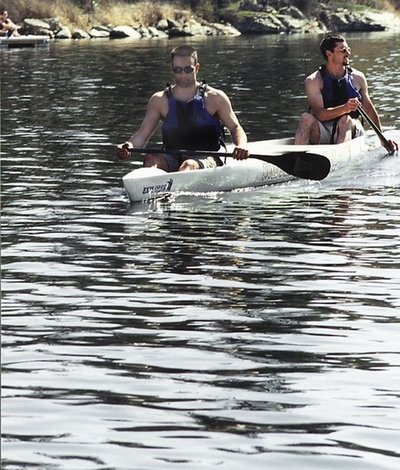June 13, 2000
UW concrete canoe team takes aim at national title
Students in the University of Washington’s civil and environmental engineering department hope to paddle their way to national acclaim later this month in a canoe made of concrete.
That’s right – concrete.
The UW team is a favorite for top honors in this year’s American Society of Civil Engineers/Master Builders Inc. Concrete Canoe Competition, an improbable nationwide contest that pits engineering students from top schools across the country against one another in designing, building and racing a concrete canoe. The event is scheduled for June 24-26 in Colorado.
“I’d say we have a 50-50 chance of winning it this year,” said Fred Mannering, chairman of the UW civil and environmental engineering department. The team swept regionals in Spokane in April. Last year, the UW finished fourth nationally, an impressive showing Mannering said would have been even stronger had not a couple of minor errors cost critical points in the close competition. “I think our team this year is even better.”
The competition, in its 13th year, is designed to give engineering students the experience of working as a member of a team on a project, from conception through construction and use. The seemingly impossible twist of building a watercraft out of concrete provides some unique challenges.
But the challenges aren’t what one might think.
“Most people hear ‘concrete canoe,’ and they say ‘It will be too heavy,'” Mannering said. In reality, concrete can be engineered to be relatively light. The real challenge is tensile strength.
“Concrete has great compression strength,” Mannering said. “But it’s poor in the tensile strength department.”
In other words, concrete canoes tend to break easily.
The UW team addressed both strength and weight concerns with computer-aided design techniques and by carefully mixing the concrete and using a new method to apply it, said Becky Farley, a civil engineering senior and leader of the student team.
Traditional concrete is made by mixing an “aggregate,” usually gravel or sand, with cement and water. The cement acts as a glue to bind the other components together. In making canoes, teams substitute lightweight materials for the sand or gravel.
The UW students used a combination of aggregates, resulting in a lightweight mix of particles of several different sizes, Farley said. Students turned to a mathematical formula known as Talbot’s Curve to determine how much of each aggregate to use so the different-size pieces would fit together as tightly as possible. That made the concrete stronger, but it also saved weight. Cement is the heaviest component in the mix, and the tighter the aggregate the less room for cement. Less cement means less weight.
“We were able to design a concrete that’s lighter than water,” Farley said. “It’s really strange to toss a block of concrete in the water and see it float.”
In applying the concrete to the mold, students used a new method known as “shotcrete application” in which the concrete mix was shot onto the canoe mold with high-pressure air. Normally, the concrete is applied by hand. The shotcrete method pushed the concrete more forcefully into the three layers of a Kevlar weave that strengthen the canoe, Farley said.
“That gave us a better bond,” she said. “It was also easier for us to control the thickness of the concrete.”
The canoe, dubbed “Explorer,” weighs in at 120 pounds, not much more than an aluminum or wooden canoe. During the competition, the craft will be propelled in five sprint and slalom/distance races by men’s, women’s and coed teams. But the races count for just 30 percent of the overall score. The balance is split among a visual evaluation of the canoe, a display, a technical paper and a five-minute presentation.
“It’s a lot like a sales meeting with a corporation in which you meet with a CEO or a board and they say ‘Tell us what you’ve got – you have five minutes,'” Mannering said. “In a lot of ways, the project is very reflective of what they’ll be doing when they graduate and get jobs.”
###
For more information, contact Mannering at (206) 543-8935 or flm@u.washington.edu. A high-resolution color image of team members paddling the concrete canoe during regionals is available on the Web at www.washington.edu/newsroom/news/images/canoehr.jpg.
Team members are practicing regularly at the UW Waterfront Activities Center in a fiberglass replica of the racing canoe and in a concrete practice canoe. The next practice is scheduled for Thursday, June 15, beginning at 6 p.m. To arrange to photograph the practice or for other practice times, contact Farley at rfarley@u.washington.edu.

